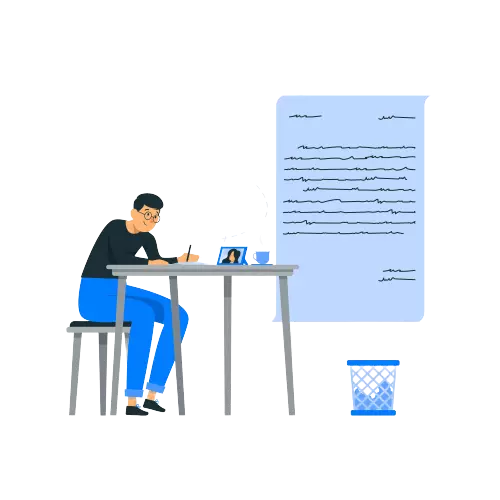Can Universities Detect ChatGPT?
Published by at May 19th, 2023 , Revised On January 15, 2025
Since the past few months, there has been a rise in the use of ChatGPT. ChatGPT is no less than a blessing for students as it saves so much of their time and energy. Thus, it gives them room to enjoy their time and complete other tasks.
Students sometimes need help to complete their coursework assignments for research proposals. Therefore, they take assistance from artificial chatbots. Students use ChatGPT to explore complex research questions.
The distinctive abilities of ChatGPT have made it an attractive tool for various academic initiatives. This chatbot has gained popularity among researchers, students, and educators worldwide.
Moreover, it is important to understand and address the limitations and considerations associated with using this chatbot in academic practices.
Understanding the Use of ChatGPT in Academic Contexts
ChatGPT has gained significant attention and adoption in academic contexts over the past few months. Its unique capabilities have opened up new possibilities for researchers and students, allowing them to explore various research questions and engage in interactive conversations.
A Research Tool
One of the primary uses of ChatGPT in academia is as a research tool. Researchers can employ ChatGPT to generate ideas, explore different perspectives, and simulate conversations to test hypotheses or analyse complex topics.
Utilised For Educational Purposes
Additionally, ChatGPT is being utilised for educational purposes. Educators and students can leverage its capabilities to facilitate learning, engage in dialogue-based exercises, and receive instant feedback.
Assisting In Gathering Data
Moreover, ChatGPT has found its place in assisting with literature reviews and information retrieval. Its vast knowledge base allows researchers to obtain relevant information, explore related work, and identify potential sources for further investigation.
Why Is There A Need For Universities To Detect ChatGPT?
Before discussing whether universities can detect ChatGPT and whether it is necessary, it is crucial to know the need for its detection. The following are a few aspects to look into:
Academic Integrity
It is crucial for the credibility and reputation of universities. Using AI tools like ChatGPT with proper verification can ensure the integrity of research findings, provide accurate information, and uphold academic scholarship.
Plagiarism
ChatGPT can result in plagiarism and a lack of originality in academic work. Students may rely heavily on ChatGPT for generating responses or writing papers without properly attributing the contributions of the AI system.
Ethical Considerations
Using AI tools in academic research can raise ethical considerations, such as informed consent, privacy, and the potential for harm or bias in generated content.
The aspects mentioned above show the importance of universities in detecting ChatGPT-generated content.
Challenges In Detecting ChatGPT Usage
Some students have relied on artificial chatbots very much. It is important to detect which assignments are AI-generated and which are not. But there are certain challenges in detecting the usage of ChatGPT for academic purposes.
The following are some challenges associated with detecting ChatGPT usage:
Indistinguishable from Human Interaction
ChatGPT is designed to generate responses that imitate human conversation. Its sophisticated algorithms enable it to produce readable and contextually relevant replies.
Hence, it makes it difficult to distinguish between interactions with ChatGPT and interactions with actual humans. This feature poses a challenge in identifying when ChatGPT is used in academic research.
Evolving ChatGPT Models
ChatGPT is constantly evolving with new updates. As a result, its responses, patterns and characteristics can change over time, making it hard to detect.
Integration into Existing Platforms
ChatGPT can be integrated into various platforms and applications through Application Programming Interfaces. This integration makes it harder to trace the use of ChatGPT.
Privacy and Data Protection
There is an evident issue of privacy. Detecting ChatGPT usage might involve monitoring user data, which raises concerns about privacy and data protection.
Academic institutions must balance detecting inappropriate use, respecting individuals’ privacy rights, and complying with relevant data protection regulations.
Contextual Understanding
ChatGPT’s behaviour can vary depending on the specific input and conversation history, which can be challenging as it gives the same results repeatedly. This AI tool
Amazing Tools To Detect ChatGPT-Generated Content
Detecting the usage of ChatGPT and other AI-based tools in academic settings can be challenging, but some technological tools can aid in the detection process.
The following are some unique technological tools that help professors and educators determine AI-generated content:
Natural Language Processing (NLP) Techniques
NLP techniques are used to analyse text data and identify patterns that indicate the usage of ChatGPT.
Examining linguistic features, syntax, and semantic structures in written interactions can distinguish between human-generated content and responses generated by AI models like ChatGPT.
Machine Learning Models
Some machine learning models are trained to detect the usage of ChatGPT based on known patterns and characteristics of its responses. The models can generalise and identify similar patterns in new data by learning from these labelled examples.
User Behavior Analysis
Analysing user behaviour and interaction patterns can provide insights into the presence of ChatGPT usage. It detects user action based on response times, and conversational patterns, and engagement levels.
It can be monitored and analysed to detect anomalous behaviour that may indicate the involvement of an AI chatbot like ChatGPT.
Metadata Analysis
Metadata associated with digital interactions, such as IP addresses, timestamps, and device information, can provide clues about the usage of ChatGPT. Analysing metadata can help identify patterns that suggest the involvement of AI models in the conversation.
Collaboration with AI Developers
Close collaboration with AI developers, such as the team behind ChatGPT, is valuable in developing detection mechanisms. If they share knowledge, academic institutions can work with AI developers to create effective tools for detecting the usage of ChatGPT.
The academic papers we write have:
- Precision and Clarity
- Zero Plagiarism
- High-level Encryption
- Authentic Sources

Collaborative Efforts To Detect ChatGPT
Detecting the usage of ChatGPT and other AI-based tools in academic settings can be more effective through collaborative efforts between industry and academia.
Industry and academic partnerships can bring together expertise from both sectors and ensure the responsible use of AI technologies in academic research.
Here are some ways in which industry and academic collaboration help in the detection process:
Knowledge Sharing
Industry partners such as the technical experts of Chat GPT and information about its characteristics can help academic institutions. They can help develop effective detection methods for educational institutes.
Data Collaboration
Collaborative efforts involve sharing relevant data between industry and academia. Academic institutions provide anonymised datasets of student interactions and usage patterns, which can help to develop better detection algorithms.
Moreover, in return, industry partners will provide access to their insights derived from real-world usage scenarios, enhancing the effectiveness of detection mechanisms.
Joint Research Projects
Collaborative research projects between industry and academia can focus on studying the usage patterns and detection methods related to AI tools like ChatGPT.
Development of Detection Tools
Collaborative partnerships can lead to softwares that assists academic institutions in detecting the usage of ChatGPT. These tools can be designed to analyse text data, metadata, and user behaviour to identify patterns indicative of AI-generated responses.
Ethical Guidelines and Policies
Collaborative efforts can also focus on developing ethical guidelines. Different industries and academic partners can collaborate to define best practices, establish transparency standards, and ensure the ethical use of ChatGPT.
Conclusion
Students worldwide are using this artificially intelligent chatbot to assist them in academics. It is an amazing research tool, but some things could be improved. Students overly rely on this tool; hence, educational institutes and some industries have taken special collaborative measures to detect its use in academic work.
Table of Contents
Though it is challenging, still some institutions have implemented measures to identify the use of AI tools like ChatGPT in academic settings.
The following are some methods that universities use to detect ChatGPT:
- Network Monitoring
- Plagiarism Detection Software
- Textual Analysis
Several commonly used tools can help identify the usage of ChatGPT or similar AI tools:
- Plagiarism Detection Software
- Network Monitoring Systems
- Machine Learning Algorithms
- Metadata Analysis
Yes, collaborations and initiatives exist between universities and AI developers to enhance the detection of ChatGPT usage and promote academic integrity. These are some examples of that:
- Research Collaborations
- Data Sharing and Analysis
- Hackathons and Competitions
- Workshops and Training






